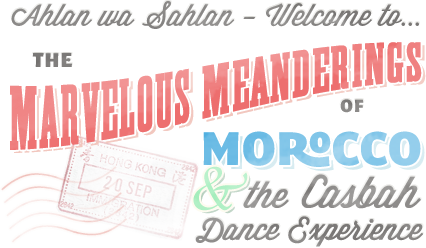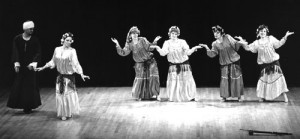Morocco, the well known dancer, was featured in a workshop which I attended September 23, in Denver, Colorado. One word – WOW! If you ever have opportunity to meet this woman don’t miss it! Morocco has been studying and teaching these dances for 35 years. She has also traveled and researched extensively in the Middle East. Don’t get the idea she’s not in great shape, though. She gets her exercise hoisting her regulation airline carry-on baggage on planes as if it doesn’t really weigh too much! (On the theory that what gets on the plane with you arrives with you!)
Morocco is an incredible combination of great all-around teacher, stand-up comedian and dance historian. Morocco quickly commented on those dancers who were overly fond of the hand by the face thing and similar moves. She explained that in the real Middle East those moves were intended as spice and used very sparingly. Unfortunately, many American dancers get their idea of the culture and the hareem from old Hollywood movies, which are themselves a very distorted view.So what was OK for Rita Hayworth, isnt necessarily a great idea for dancers to imitate.
Even though Ive been dancing for about ten years now, I really appreciated the workout which Morocco gave us on hip articulation. In addition to discussing the basic principles of hip articulation, she led us in a 3 1/2 hr. workout and choreography. And to keep things from getting too tense, she didnt hesitate to use humor to illustrate her point, how a shimmy feels… flap,flap,flap vs.how the movements actually looks – much more subtle. In fact, she noted, that part of the problem was that moves which felt very subtle, actually looked bigger, like the shimmy. She also noted that using a lot of floor space was a very modern concern. Referring to belly dance as one of the oldest continuous dance forms, she noted that it involved primarily the torso and arms in its earliest forms.
When we finished with the hip articulation (more work than I’ve done in years!), she asked everyone to take off the hip belts because we were going to do Guedra! I couldn’t believe it – I’d been trying to research this dance for the past year or two and hadnt been able to find much. And here she was, just giving it to me! Guedra is the trance ritual of the Tuareg, a North African tribe also know as the blue people. They really ARE blue. they use a fabric coloring process which involved pounding blue powder into the cloth with a stone: well, why not? This is the desert and there’s not a lot of water to waste. Since they also don’t take a lot of baths, this blue powder rubs off on their skin. They are also a matriarchy where the women engage in contests of strength. The men are known as some of the fiercest warriors in the desert, and some of the best traders. They are also the only culture where the men, not the women are veiled. Despite any comments you might hear about the Guedra dancers as prostitutes, the truth is that in their culture it is considered an advantage to gain experience in love – both men and women have many lovers before marriage. Another reason for misunderstanding is that during a performance in the early 1900s, one of the performer’s breasts slipped over the top of her haik & the European male viewer assumed it was intentional. But, as Morocco mentioned, in this part of the world, the female breast is considered more utilitarian than erotic. I think this lends more credence to the idea that this dance predates Islam. North Africa is populated with many Berber tribes which admittedly have many pagan beliefs and do not identify with the Muslim population. Guedra uses Muslim chants in its songs, but it obviously has other associations. If you’d like to see a Tuareg man, check the movie Sheltering Sky. Although not noticeably blue, the desert nomad who rescues the woman at the end in a very steamy, erotic ending, has to be Tuareg.
The Guedra is the Tuareg Blessing ritual. Unlike other trance dances of the Middle East (the Zar, the Hadraa), it does not involve the exorcism of demon spirits or killing chickens. It is purely beneficial and joyful. The Guedra which Morocco audio-taped at King Hassan’s palace was three hours long. It is possible to give the feeling of the dance in a shorter time frame for American audiences. Morocco performed the dance that evening for us. I had the distinct feeling though, that she would have been much happier if the flash cameras had been banned. The moves are simple, but like all trance dances, you must lose yourself in the movement and feel it before you can truly make it work. And the thing about trance dances is that they do work, i.e. inducing altered states of consciousness – any drummer knows that from experience.
The basic rhythm is a one-TWO. The difficult part was getting used to working the 2nd beat instead of the first, especially in the embellished, authentic version, The basic move is a hand flick. Doing this in different ways gives different meanings. The dance begins with the head covered by the end of the garment (a haik, with a caftan worn underneath; color is Goulemine blue or black). This symbolizes being in darkness and lacking understanding or knowledge. The dancer begins her hand moves and gradually lifts the material back onto her headdress when she feels ready.
The clothing/costume is essential to the dance. The headdress is decorated with cowrie shells, as are the braids which wrap and hang from it. The dancer weaves her hair in with the fake hair to hold in the head piece.This is a decorated wire framework – one piece circling around the top of the head and one arcing from the top of the frontspiece to the back of the bottom circlet. Other versions appear to be merely a mass of braids circled at the top of the head. This is very practical for desert wear, since it leaves an airspace open above the head. It also means that the only parts which would show well are the hands and face, and a few foot movements. Foot movements are mostly flat-footed with some toe-toe, heel-heel, slide movements to the side, The dance begins with hand flicks to the four directions (north, south, east,west), then to the elements: fire (up), earth (down), wind (out), water (moving in).
The hands also represent time elements: to the back (the past), to the side (present), and to the front (future). Morocco also mentioned that in the East they believe the heart is fickle, so if you truly mean something you say, I feel it in my liver! Therefore, to truly bless someone, you flick from the liver/stomach area, the heart, then the head. Periodically, you may flick toward yourself, to gather back in some of the energy which you have sent out. As momentum builds, you may feel compelled to add head sways, which will make your braids swing back and forth, All of these moves should be sharp, accented ones – not graceful, delicate ones.
You may also end on the floor if the spirit moves you, In fact, Morocco said, she has to be careful to remember when she’s doing a performance demonstration not to get too involved. She has actually tranced out and ended up on the floor without planning it!
I’m planning to find an appropriate event and teach Guedra at an SCA gathering in the coming year. I think it would be perfect for outdoor teaching in the summer or at Arts and Science events. However, I would hate to see it done as some kind of feast entertainment which no one understands or pays attention to.
If you would like to contact Morocco directly about the Guedra information, she can be reached at: morocco@casbahdance.org. She has DVDs of the Marrakesh Folk Festival as well as one of her troupe performing Guedra for sale.
References:
”Guedra: Spreading Souls Love and Peace to the Beat of the Heart” by Morocco HABIBI, Summer 93, vol. 12, No.3 P.4
“Morocco and its Dances” A 2 part series by Donna Lea Smith.
ARABESQUE:Pt 1:Vol VIII, No. 3, Sept-Oct, 1982. Pl 14. PT II: VolVII, No 4, NOv-Dec, 1982. P.10
”Dances of the Maghreb” A series by Dr. Bettina Knapp. ARABESQUE: PTII:VolXIV, No.3, Sep-Oct. 1988, P. 8. PT III: Vol IV, No. 4, Nov-Dec, 1988, P.8

